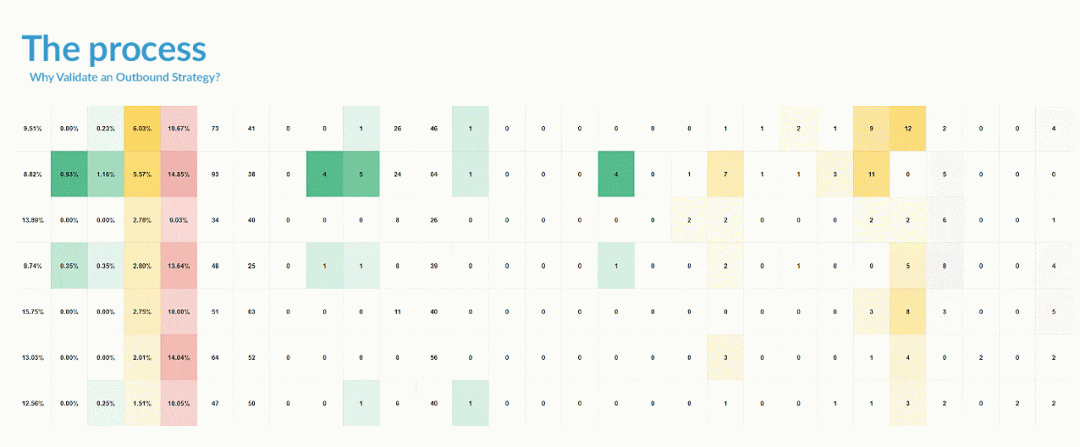Why Validate an Outbound Strategy?

If Predictable Revenue were a store, we’d sell customers.
Of course, our business isn’t quite like your favorite neighborhood shop, but our clients do come to us because they want more customers. And, thus far in our 7 years of service, it’s been all kinds of customers – the enterprise market, the consumer packaged goods market, the food and beverage industry…the list goes on.
We can connect you with relevant executive buyers in whatever type of organization you need.
But the question that we’ve realized lies at the heart of outbound success for our clients is not just honing in on a particular market and an Ideal Customer Profile (although those are always important considerations): it’s whether or not you want more customers like the ones you already have, or you want a brand new segment of customers.
If it’s the former, then outbound success becomes an issue of execution and driving results – more prospects, refined messaging, and better cold calls. You know your customers well already, we just need to help you turn up the volume. If it’s the latter you seek, however, there’s a bit more work to do. We need to figure out what makes your product relevant to the people you want to sell it to – probably in more detail than your current assumptions. This is the first step in any successful outbound sales program.

That’s why we created an innovative new program called Outbound Validation.
With Outbound Validation, we spend more time upfront determining and mapping out the various guesses, hypotheses, and hunches about why a new segment of customers would want your product or service. If finding more of the same customer is an exercise in pouring gas on the fire, then Outbound Validation is an exercise in planning, testing, and iterating to determine what works and find the spark that ignites the fire (before we pour gas on it).
Our clients do this with us by working through a concept called chain of relevance. The chain of relevance is a systematic breakdown of a type of company, a targetable persona, the persona’s responsibilities, goals, jobs to be done, and any obstacles or friction getting in their way.
For every audience you are trying to connect with – for instance one example could be, Chief Information Officers in the Manufacturing Industry – we verify that they have a responsibility relevant to your offering, we then take educated guesses at what their current goals would be based on market trends, what jobs their division needs to get done to accomplish those goals, and what obstacles they are probably facing. We then design a campaign for each combination of guesses and evaluate how people respond. This works for any B2B market – especially executive buyers.
Testing systematically like this is very common in the marketing world, but unlike most marketing experiments we aren’t just measuring clicks or conversions, we are actually engaging people in sales conversations and learning from their qualitative responses.
The reality is that people are going to care about things in slightly different ways, regardless of how similar their positions or roles may sound, and we are trying to optimize for each of them. That’s why we test as much as we do: we’re looking to hit on those subtle nuances in messaging copy that speak to a particular audience you want…so we can do more of it.
What’s the specific value proposition that worked? Was there more than one? And what persona or market responded most positively?
Through Outbound Validation, we’ll find out. And we’ll suggest a clear path forward for connecting with those prospects, at scale, that includes nuanced insights gleaned from our various experiments, as well as tailored channel strategies to increase response rates.
The Process
We will guide you through 2-3 online workshops to unpack your theory of why your customers need your product. Together, we then break that theory up into individual hypotheses that we can test. Finally, we deploy robust email campaigns to test those hypotheses, and manage all the engagement on your behalf. You immediately get introduced to anyone that is interested in buying, and we ask follow-up questions to anyone who responds in an ambiguously negative or neutral way. Once the campaigns are wrapped up, we crunch all the metrics and review the results with you to ensure you learn as much as possible from the experiments.
One of the results you get is a heat-map that highlights which combinations of customer segment and value prop led to which types of positive, neutral and negative engagement. That heat-map looks something like this:

Almost every time, the positive results will cluster around a couple combinations of targeting and messaging – the evidence you need to invest bigger in that strategy.
Go wide, then deep
Underpinning the success of Outbound Validation is the sheer number of experiment campaigns we run for our clients. For each client we run up to 20 experiments a month, which usually involve a combination of 3-7 different market segments and 3-7 different ways of framing their need.
That results in us finding the right people, and the right things to say to those people, up to 5 times faster than before. When you’re trying to break into a new market – that time saved can be critical. Of course, you can use that time to send LinkedIn messages and fumble around with new emails, hoping for a response, or that you even guessed right about your new market in the first place.
But what if you’re wrong?
Getting brand new customers is hard. Guessing makes it harder. Why not test it all up front and scale up only what works?